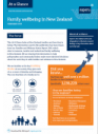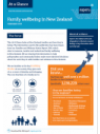Here you’ll find regional data on the wellbeing of families and whānau across the different regions of New Zealand:
- National
- Northland
- Auckland
- Waikato
- Bay of Plenty
- Hawke’s Bay
- Gisborne
- Taranaki
- Manawatu-Whanganui
- Wellington
- Marlborough & Nelson
- West Coast & Tasman
- Canterbury
- Otago
- Southland
Regional data about families and whānau looks at the predominance of different family types nationally and in each region, their ethnicity, and their wellbeing. To assess wellbeing, these reports look at indicators like health, safety and environment, relationships and connections, identity, economic security and housing, and skills and employment.
This regional information is based on the data published in the Families and Whānau Status Reports, which look at the make-up and wellbeing of New Zealand families and whānau. Families and whānau research is a multi-year project, for which we publish a technical report with a different theme in June each year. In 2015, it included wellbeing indicators for the first time, and in 2016 we looked closely at ethnic diversity.



